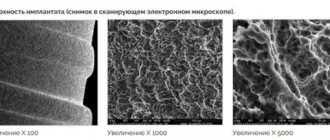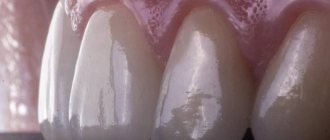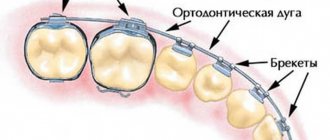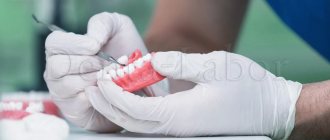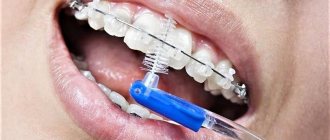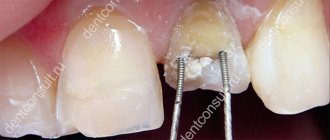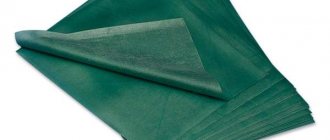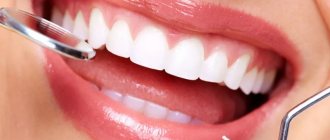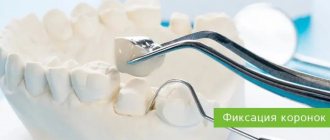Methods of tooth restoration in modern dentistry
Dental restoration methods in modern dental clinics make it possible to completely recreate the shape, color, shine, transparency and light refraction of dental tissue.
I would like to proudly note that teeth restored at the Interdent dental clinic are considered healthy even by dentists from other clinics. What teeth are subject to restoration and what methods of restoration exist? To begin with, it should be noted that teeth that are subject to restoration often require endodontic treatment. Removing inflamed dead pulp residues from the canals, then making a high-quality filling. Without professional root canal treatment, there is no point in proceeding with the actual restoration. The remains of dead tissue, “immured” in the roots or under the roots, will sooner or later make themselves felt by pain or swelling of the gums. Very rarely, a tooth is destroyed in such a way that it needs to be restored with living pulp. In such cases, after a thorough diagnosis, the doctor restores the tooth, keeping it alive. The restoration itself can be single-stage or multi-stage.
Is it so easy to put an invisible filling on a front tooth?
If the tooth is not very badly damaged, you will be offered to restore it with a filling. Aesthetic restorations made in one visit to a dentist are called “direct”.
The procedure for restoring a chipped part of a tooth seems simple, but it is not: the tooth is unevenly colored - it is darker at the gums, and almost transparent at the cutting edge. It will surprise you to know that teeth contain colors ranging from pink to blue, but the main shades are yellow, brown and gray.
Only with practice does a dentist develop an intuitive understanding of the sequence and which shades to use when layer-by-layer restoration of a particular tooth.
If you are interested, watch a video about how aesthetic restoration of the front teeth is done using Enamel plus material.
One-step restoration
One-stage restoration is a therapeutic procedure, while multi-stage restoration is the restoration of a tooth using an orthopedic method (inlays and veneers). A tooth in need of restoration is significantly damaged, and often, in order to restore the shape of the tooth therapeutically, it is first necessary to install a pin in the root. Pins are available in metal and fiberglass. The latter have little flexibility, which completely prevents root fracture during installation. And they come in white and transparent, which eliminates the influence of their color on the final color of the filling.
Fiberglass posts are more expensive than metal ones, but they are preferable for anterior teeth where esthetics are important. Next, the filling mass is applied layer by layer to the installed pin, like a frame. And this is where the real art begins.
The doctor is not limited in time, because The filling will not harden until it is exposed to the light beam of a gel lamp. But the amount of each layer of material, the sequence of application of different shades, the actual choice of color, and ultimately the modeling depend solely on the professionalism of the dentist. Next, the filling is ground and polished, giving it a final sparkling shine.
Restoration of a dentition defect in the anterior region using an adhesive structure
Many domestic and foreign authors do not believe that restoration of a dental defect in the form of the absence of one tooth is necessary in every case. In their opinion, the loss of one functional unit does not necessarily affect chewing efficiency. At the same time, the statement about the need to restore the integrity of the frontal part of the dentition for aesthetic reasons is indisputable and unambiguous.
Depending on the clinical situation, taking into account the wishes of the patient himself, the dentist determines the indications for choosing a treatment method. If until recently the main method was considered to be prosthetics with a ceramic-based bridge, today the method of choice can also be the production of an orthopedic structure on an implant or an adhesive bridge. Moreover, the latter can be simulated by a dentist-therapist in one visit.
Clinical case
Patient N., 40 years old, complained of the absence of the right central incisor of the upper jaw (Fig. 1).
Rice. 1. Initial clinical situation: included dentition defect.
From the anamnesis it turned out that the tooth was lost as a result of an injury received during sports competitions. The wound healing took a long time with the formation of an atrophic scar in the area of the lost tooth. The patient refused repeated surgical intervention or orthopedic treatment and consented to the manufacture of an adhesive bridge prosthesis.
The location of the defect in the anterior part of the dental arch dictates the use of highly aesthetic composite material and fiberglass tape.
At the preparatory stage, professional oral hygiene and training in individual dental care were carried out. The patient signed a reasoned consent to perform the planned manipulations.
The first stage of working with photopolymers is the mechanical treatment of teeth with fluoride-free paste applied to a special brush.
After this, the teeth are rinsed with a stream of water and proceed to the next stage - choosing shades of color using the color of the material used. The dentist follows rules that exclude the influence of background and lighting on the perception of tooth shades. Optimal conditions for this stage allow for close-to-gray painting of walls, napkins, and preliminary testing of the assistant.
The usual methodology for selecting opaque and enamel composites for modeling a missing incisor is followed by comparing photopolymer standards with individual sections of a symmetrical 21 tooth (Fig. 2).
Rice. 2. Determination of shades of color.
The type of transparency of the enamel and the shape of the mamelons at the cutting edge are also noted. The results are recorded in a special card: the planned tooth 11 in the cervical area has opaque and enamel shades A3, the main volume of lost dentin and enamel requires shade A2, the transparent cutting edge is 1 mm wide. This choice corresponds to the symmetry of color and the type of transparency of the hard tissues of the anterior teeth.
The size and shape planning stage includes odontometry, odontoscopy and preparation of adhesive tape of optimal length.
Knowing the size of the tooth that is symmetrical to the removed one will allow you to create an accurate design. The measurement results indicate an excessive distance between the teeth limiting the defect: 8.2 mm with a width of 21 teeth of 8 mm (Fig. 3). In this regard, it is planned to slightly increase the mesiodistal sizes of teeth 21 and 12.
Rice. 3. Odontometry of teeth, design planning.
In place of the missing incisor, an artificial tooth will be modeled so that its dimensions correspond to the central incisor on the left. Separately, the height of the crown in the proximal region (from the gum to the incisal edge) was assessed to select the width of the tape, which should be about 1/2 of the obtained height of the proximal wall. In this case, preparing the site for the tape does not destroy the corners or ridges of the intact crown. To measure the length of the tape, a strip of foil of approximate length was cut out (the size of the defect in the dentition plus 4 mm). The exact length of the tape was determined after the teeth were prepared.
In order to strengthen the tape, depressions were formed on the mesial surfaces of the teeth closing the defect (Fig. 4). The height of the prepared areas corresponds to the width of the tape; in depth - 1-2 mm (slightly go deeper into the dentin); in length they occupy almost the entire width of the proximal wall, without protruding beyond the vestibular surface.
Rice. 4. On the mesial surfaces 12 and 21, areas for the adhesive prosthesis were prepared.
The mesial surfaces of teeth 21 and 12 were also subjected to preparation with a slight transition to the vestibular surface, creating the roughness necessary for adhesive preparation.
Protruding edges were smoothed with a fine-grained bur. Then the exact length of tape required to model the adhesive prosthesis was measured. Using tweezers, a pre-prepared strip of foil was placed so that one end fits tightly to the prepared area of the 21st tooth, starting from the vestibular surface towards the palatal surface, extending it to the 12th tooth, which closes the defect on the opposite side, and laying it on the prepared area in the same way (Fig. 5).
Rice. 5. A strip of foil of the required length is measured.
The free end of the foil tape was cut off so that it did not protrude beyond the site, while avoiding damage to the foil, which served as a matrix for preparing the base of the adhesive bridge. Using scissors, we cut the tape to exactly the same length as a strip of foil: a piece of tape that is too short will not strengthen the structure, and a piece that is too long will protrude beyond the site.
The next step was etching the prepared areas and mesial surfaces with acid gel in accordance with the instructions for the adhesive system used: 15 sec. - dentin; 30 sec. - enamel, rinse the teeth with a stream of water and dry with fat-free air.
A thin layer of adhesive bond (not self-etching) was applied to the prepared surfaces and polymerized for 20 seconds. The adhesive was then coated with a thin layer of flowable composite (not polymerized).
A pre-prepared piece of fiber was placed using tweezers, a probe, or a smoothing iron in such a way that it covered the defect.
To do this, using tweezers, one end of the tape was tightly pressed to the prepared area of 21 teeth (coated with a flowable composite), after which this area was polymerized. Premature hardening of the material was prevented by eliminating direct rays from the dental unit lamp. The tape was bent so that it extended to the 12th tooth, the end of the tape was bent inward and the outer side was pressed against the proximal area in the direction from the palatal to the vestibular surface of the tooth (the edges of the tape should not protrude beyond the boundaries of the areas) and polymerized (Fig. 6).
Rice. 6. Both ends of the tape are reinforced.
Exposure to light from a halogen lamp separately for 20 seconds. Each section of the tape was cured, after which the intermediate part of the structure was prepared for modeling an artificial tooth on it.
The formation of the 11th tooth was preceded by correction of the width of the interdental space by applying a thin (0.7 mm) layer of transparent enamel composite to the mesial surfaces of the teeth closing the defect.
This manipulation made it possible to reduce the transverse parameters of the restoration to the size of a symmetrical incisor.
The reconstruction of the upper central incisor on the pontic of an adhesive bridge is similar to the formation of a veneer, and therefore follows the steps of working with a composite. Closer to the cervical area, a dark opaque layer of OA3 was applied (Fig. 7). The next dentin layer, lighter, OA2, replenished the volume of lost dentin (Fig. 8).
Rice. 7. The tape adapted to the teeth is covered with an opaque layer of composite material.
Rice. 8. The mamelon of the 11th tooth is modeled.
The contours of the restoration implied the preservation of the anatomical shape of the tooth. The vestibular surface is smooth, there are no vertical ridges.
The length of contact between the lateral surfaces is significant: from the top of the interdental papilla to the cutting edge.
The angle sign is clearly defined, the curvature of the crown is weakly expressed (Fig. 9). The mamelons at the cutting edge have an individual pattern (Fig. 10). The main small relief details were modeled using enamel shades. A thin transparent layer was distributed evenly over the entire surface to recreate the optical properties of natural hard tooth tissues.
Rice. 9. The base of the artificial tooth is formed from opaque.
Rice. 10. Control odontometry (comparison of the width of the left and right central incisors).
The cutting edge was modeled with a transparent enamel composite, repeating the shape and relief of a symmetrical incisor (Fig. 11).
Rice. 11. The vestibular surface of the 11th tooth is made with enamel shades of the composite.
After the formation of a restoration in place of the missing 11th tooth, corresponding in size and shape to a symmetrical incisor, a lateral examination reveals a gaping interdental space that requires further correction of the work performed using a pink-colored composite.
Using special standards, the base (opaque) material is selected (Fig. 12). An opaque pink composite with a layer of no more than 2 mm is applied to the prepared areas (12 teeth and restorations), an interdental papilla is modeled, which is symmetrical in shape: slightly convex, has a wide base and a pointed apex (Fig. 13).
Rice. 12. Selection of shades of color of the gingival margin.
Rice. 13. The base of the gingival papilla is modeled using pink opaque photopolymer.
Pink composite fills the gaping interdental space.
The opaque photopolymer is cured by light from a halogen lamp.
The entire surface of the formed interdental papilla is covered with a transparent layer, which will provide the natural shine and volume of the artificial structure (Fig. 14).
Rice. 14. An artificial gingival papilla is modeled.
Mechanical surface treatment was carried out using diamond burs of fine and ultra-fine grain, polishing discs, and heads (Fig. 15-18).
During the work, the preservation of macro- and microrelief was monitored. To obtain a natural shine, felt brushes were used.
Rice. 15. The proximal surfaces of the artificial tooth are treated with bur.
Rice. 16. Contouring of the vestibular surface of the 11th tooth with a fine-grained diamond bur.
Rice. 17. Treatment of the adhesive prosthesis with a fine disc.
Rice. 18. Polishing the restoration with a brush.
In order to prevent disruption of the marginal seal at the filling-tooth interface, the free surfaces of the teeth were coated with fluoride-containing varnish.
Figure 19 shows a finished aesthetic adhesive structure that restores the missing 11th tooth and replicates the shape and color of natural teeth.
Rice. 19. Ready-made adhesive prosthesis.
The fluorescence of the restoration also corresponds to a symmetrical tooth (Fig. 20).
Rice. 20. When the incisors are illuminated with short-wave light, the completed structure fluoresces like the hard tissues of neighboring teeth.
Conclusion
Modern technologies in therapeutic dentistry make it possible to model restorations that are an alternative to more complex and expensive orthopedic structures, which in some cases require significant tooth preparation or surgical intervention on the alveolar ridge. Adhesive reinforcing fibers provide sufficient stability of the AMP, and photocurable composite materials meet the aesthetic requirements of the patient.
If necessary, special pink polymers can be used to imitate the gingival margin. It should be remembered that the use of advanced methods and materials requires a high level of competence, professionalism, skills and manual skills from a dentist working in the field of aesthetic dentistry.
Literature
- Guide to dental implantology
/ D. A. Hobken, R. M. Watson, L. D. D. Syzn. - M., 2010. - 223 p. - Mish K.E. Orthopedic treatment based on dental implants.
- M., 2010. - 615 p. - Zagorsky V. A., Robustova T. G. Dental prosthetics on implants.
- M., 2011. - 256 p. - Lutskaya I.K. Fundamentals of aesthetic dentistry.
- Minsk: Modern School, 2005. - 332 p. - Lutskaya, I.K. Master class on aesthetic dentistry
and / I.K. Lutskaya, N.V. Novak: Medical literature, 2009. - 144 p. - Lutskaya I.K. Modern filling materials and methods of work in restorative dentistry
/ I.K. Lutskaya: Rostov n/D: Phoenix, 2004. - 413 p. - Behr M, Rosentritt M, Ledwinsky E, Handel G. Fracture resistance and marginal adaptation of conventionally cemented fiber-reinforced composite three-unit FPDs.
Int J Prosthodont 2002; 15: 467–472. - Freilich MA, Meiers JC. Fiber-reinforced composite prostheses.
Dent Clin North Am 2004; 48:545–562. - Lutskaja, I. Making a combined aesthetic structure
/ I. Lutskaja, N. Novak, V. Gorbachev //
DPR EUROPE
. — 2008. — june/july. - P. 12-15.
Restoration with veneers
A veneer is a ceramic or composite “facet” that is attached to the front (front) surface of the tooth with special light-curing cement. Veneers are used to restore mainly the front group of teeth, the color and shape of which are of particular importance. In order to restore a tooth with a veneer, only the front and slightly cutting surfaces of the tooth are ground down within the enamel layer by only 0.5 mm. Naturally, for this purpose the tooth does not need to be depulped (removing the nerve), unless there are other indications.
Then impressions are taken of the ground tooth or group of teeth, the color is determined, and a ceramic or composite “onlay” is made in the laboratory.
Veneer, unlike filling material, does not change color over time and does not lose its shine. Moreover, a veneer, unlike a one-step tooth restoration, has a clearer marginal fit to the gingival tissue, which is important for the prevention of periodontal diseases.
Teeth colors
This is where the color scale comes to the rescue, in which the teeth are divided into groups depending on the shades and their intensity.
It would seem that it would be difficult, given a scale, to find the desired color match. However, the choice is not as obvious as it might seem. Any surrounding colors, especially bright ones, from the patient’s makeup to the color of furniture and walls, disrupt the perception of shades.
The perception of colors is purely individual, and also deteriorates with age, so often when choosing a color, the doctor asks the opinion of the assistant and his colleagues. Lighting plays an important role in determining color (it can be artificial, natural or mixed).
Since the veneer and crown are placed on a ground tooth, it is necessary to predict what color this combination will produce.
Restoration with tabs
Inlays are also made in the laboratory and come in ceramic and composite. The teeth for inlays are processed in the same way as for filling materials, i.e. all carious dentin is removed, a cavity is formed, and then impressions are taken from it and sent to the laboratory. The finished inlay is attached to the tooth in the same way as a veneer. The advantage of inlays over filling material is that inlays do not undergo polymerization shrinkage, i.e. do not shrink in volume like filling material under the influence of a light beam from a gel lamp. Further, when restoring with inlays teeth that are destroyed in the area of the contact surface with another tooth, almost one hundred percent restoration of the contact point is ensured, which is very important for interdental hygiene.
Veneers and inlays are not polished, since they are provided with shine already in the laboratory. Teeth restored simultaneously with composite filling materials must be polished every 6 months due to the fact that the surface layer of the light-curing composite, the structure of which differs from the structure of the enamel, wears out, becomes rough and retains microparticles of food debris and microbes.
Of course, it is up to the specialist to decide whether to restore using filling material or an orthopedic method, but there are situations when the doctor can offer both options for restoring a tooth, justifying all the pros and cons. Naturally, restoration with veneers and inlays is more expensive, but having paid once for quality treatment, you will not have to periodically return to the doctor with the same problem.
Malocclusion and pain in the spine
An unreplaced tooth violates occlusion - the correct physiological closure of the remaining teeth of the upper and lower jaw. Not immediately, but after a few years this will lead to the appearance of painful sensations - first in the temporomandibular joint, and then in the cervical spine, and, as a result, to regular headaches.
Our body is truly one whole. Therefore, a lower jaw displaced back or upper teeth protruding forward can cause the appearance of associated skeletal problems - from flat feet to scoliosis. This is well known to dentists and patients of orthodontic centers.
When a person finally wants to do implantation and install a denture on an artificial root, he will first have to correct the bite with braces or aligners.
We insert the teeth completely: prosthetics of two jaws
Which prosthesis should I choose if I have no teeth at all? Contact the German Implantology Center - the doctor will choose a way to restore your health. Preference is given to implantation. The statement that it is expensive is outdated. Today you can get an installment plan. Implants are installed once and with a lifetime guarantee - clinic dentists work only with the premium segment from well-known manufacturers, and expensive traditional removable structures wear out and require replacement after 7-10 years.
Our Center is a certified partner of top-rated implant brands, which is why patients all over Russia and abroad trust us. If it is necessary to restore the dentition on two jaws, the treating doctor will prescribe an examination and draw up a detailed action plan for dental prosthetics on implants. A tomogram is performed, a 3D model or surgical template is created, providing a predictable result. We use the best tomograph models in the world – cone versions of the Planmeca line.
The dentist chooses the priority of actions and introduces implants according to the “All on 4” or “All on 6” protocols. These are ways to carefully, avoiding unnecessary trauma, improve the quality of life.
Dental implantation is completely performed in most cases without bone grafting.
- For total rehabilitation, sometimes 4 implants are enough to fix the prosthesis on the lower jaw - this is 20% of all requests.
- The bone of the upper jaw is more porous, so 6 supports may be needed to secure the structure - the need to use one of the methods will be discussed by the doctor during a consultation after the examination.
The treatment plan must be discussed with the patient.
Example #6 - Prosthetics of both jaws with implantation ALL ON 6
Our patient is a 49-year-old man. I came across the following difficult situation:
- severe periodontitis,
- partial absence of teeth,
- numerous caries, incl. deep
- bone tissue atrophy.
The situation was more than serious, look for yourself at the photo BEFORE the start of treatment
:
The result of the prosthetics exceeded all the patient’s wildest expectations, see for yourself:
And with a smile, the result of ALL ON 6 is simply fantastically beautiful:
You can read this clinical case in detail HERE.
